1.Data Mining
1.Attributes and Objects
- What is Data?
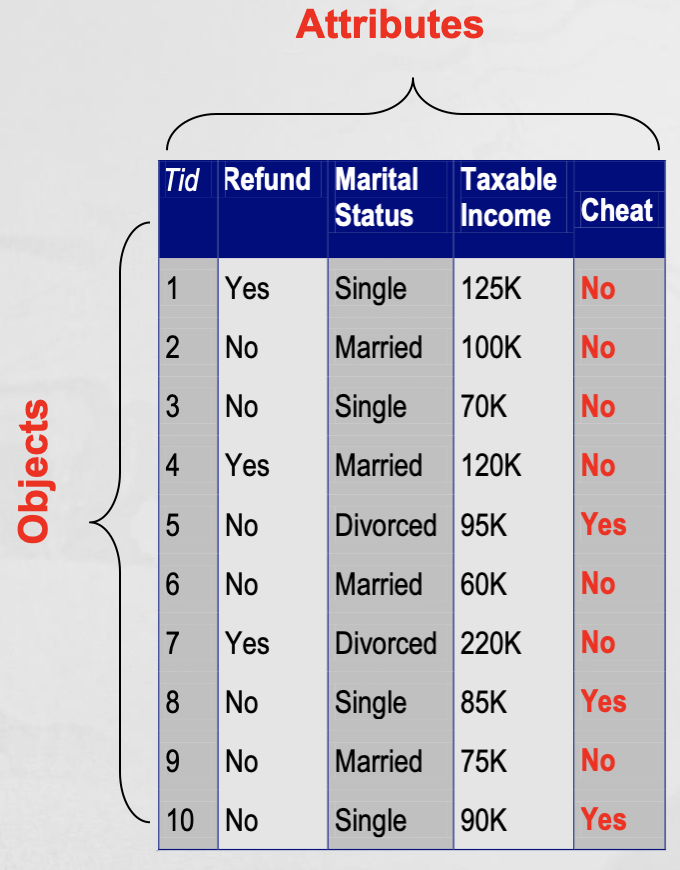
-
Collection of data objects and their attributes
- An attribute is a property or characteristic of an object
- Example : eye color of a person, temperature, etc.
- Attribute is also known as variable, field, characteristc, dimension, or feature
- A collection of attributes describe an object
- Object is also known as record, point, case, sample, entity, or instance
- A more Complete View of data
- Data may have parts
- Attibutes (objects) may have relationships with other attirbutes (objects)
- More generally, data may have structure
- Data can be incomplete
- We will discuss this in more dtail later
- Attribute Values
- Attribute values are numbers or symbols assigned to an attribute for a particular object
- Distinction between attributes and attribute values
- Same attribute can be mapped to different attribute values
- Example: height can be measured in feet or meters
- Same attribute can be mapped to different attribute values
- Different attributes can be mapped to the same set of values
- Example: Attribute values for ID and age are integers
- But properties of attribute values can be different
2.Types of Data
- 데이터 셋은 객체로 구성된다
- entity, 레코드, 점, 벡터, 패턴, 사건, 사례, 표본, 케스 등의 명칭 사용
- 객체는 물리적 객체의 질량이나 사건이 일어난 시간과 같이 주어진 객체의 기본적 특성을 표현하는 다수의 속성에 의해서 기술된다
- 변수, 특성, 특징, 차원, 필드
-
attribute 먼저, 그 다음 object 순서로..
- Tpyes of attributes
- There are different types of attributes
- Nominal
- Ex : ID numbers, eye color, zip code
- Ordinal
- Ex : rankings (e.g, taste of potato chips on a scale from 1-10), grades, height(tall,medium,short)
- Interval
- Ex : calendar dates, temperatures in Celsius or Fahrenheit
- Ratio
- Ex : temperature in Kelvin, length, counts, elapsed time (e.g., time to run a race)
- Nominal
- There are different types of attributes
- Properties of Attribute Values
- Distinctness : = ≠
- Order : < >
- Differences are meaningful : + -
- Ratios are meaningful : * /
- Nominal attribute: distinctness
- Ordinal attribute: distinctness & order
- Interval attribute: distinctness, order & meaningful differences
- Ratio attribute: all 4 properties/operations
- Difference Between Ratio and Interval
- Is it physically meaningful to say that a temperature of 10 ° is twice that of 5° on
- the Celsius scale?
- the Fahrenheit scale?
- the Kelvin scale?
- Consider measuring the height above average
- If Bill’s height is three inches above average and Bob’s height is six inches above average, then would we say that Bob is twice as tall as Bill?
- Is this situation analogous to that of temperature?
- Is it physically meaningful to say that a temperature of 10 ° is twice that of 5° on
- Categorization of attributes is due to S.S. Stevens
- Categorical Quantitative
- Nominal : Nominal attibute values only distinguish (=,≠) (e.g., zip code, employee ID numbers, eye color) , (Operations : mode enthropy, contingency corrlation)
- Ordinal : Ordinal attibute values also order object (<,>) (e.g., hardness of minerals, grades, street numbers) , (Operation : median, percentiles, rank corrlation, run tests, sign tests)
- Numeric Quantitative
- Interval : For interval attributes, differences between values are meaningful (+,-) (e.g., calendar dates, temperature in Celsius or Fahrenheit) , (Operation : mean, standard deviation, Pearson’s correlation)
- Ratio : For ratio variables, both differences and ratios are meaningful (*,/) (e.g., temperature in Kelvin, monetary quantities, counts,age, mass, length, current) , (Operations : geometric mean, harmonic mean, percent variation)
- Categorical Quantitative
- Nominal : Any permutation of values (Comments : If all employee ID numbers were reassigned, would it make any difference?)
- Ordinal : An order preserving change of values (Comments : An attribute encompassing the notion of good, better best can be represented equally well by the values {1,2,3} or by {0.5 , 1, 10})
- Numeric Quantitative
- Interval : new_value = a * old_value + b where a and b are constants (Comments : Thus, the Fahrenheit and Celsius temperature scales differ in terms of where their zero value is and the size of a unit)
- Ratio : new_value = a * old_value (Length can be measured in meters of feet)
- Categorical Quantitative
- Discrete and Continuous Attirbutes
- Discrete Attribute
- Has only a finite or countably infinite set of values
- Examples: zip codes, counts, or the set of words in a collection of documents
- Often represented as integer variables.
- Note: binary attributes are a special case of discrete attributes
- Continuous Attribute
- Has real numbers as attribute values
- Examples: temperature, height, or weight.
- Practically, real values can only be measured and represented using a finite number of digits.
- Continuous attributes are typically represented as floating-point variables.
- Discrete Attribute
-
Asymmetric Attiributes
- Only presence (a non-zero attribute value) is regarded as important
- Words present in documents
- Items present in customer transactions
-
If we met a friend in the grocery store would we ever say the following? “I see our purchases are very similar since we didn’t buy most of the same things.”
- We need two asymmetric binary attributes to represent one ordinary binary attribute
- Association analysis uses asymmetric attributes
- Asymmetric attributes typically arise from objects that are sets
- Only presence (a non-zero attribute value) is regarded as important
-
Key Messages for Attribute Types
- The types of operations you choose should be “meaningful” for the type of data you have
-
Distinctness, order, meaningful intervals, and meaningful ratios are only four properties of data
-
The data type you see – often numbers or strings – may not capture all the properties or may suggest properties that are not present
- Analysis may depend on these other properties of the data
-
Many statistical analyses depend only on the distribution
-
Many times what is meaningful is measured by statistical significance
- But in the end, what is meaningful is measured by the domain
-
- The types of operations you choose should be “meaningful” for the type of data you have
2.3 Types of data sets
- Type
- Record
- Data Matrix
- Document Data
- Transaction Data
- Graph
- World Wide Web
- Molecular Structures
- Ordered
- Spatial Data
- Temporal Data
- Sequential Data
- Genetic Sequence Data
- Record
- Important Charateristics of Data
- Dimensionality (number of attributes)
- High dimensional data brings a number of challenges
- Sparsity
- Only presence counts
- Resolution
- Patterns depend on the scale
- Size
- Type of analysis may depend on size of data
- Dimensionality (number of attributes)
- Record Data
- Data that consists of a collection of records, each of which consists of a fixed set of attributes
-
Data matrix
-
If data objects have the same fixed set of numeric attributes, then the data objects can be thought of as points in a multi-dimensional space, where each dimension represents a distinct attribute
-
Such a data set can be represented by an m by n matrix, where there are m rows, one for each object, and n columns, one for each attribute
-
- Document Data
- Each document becomes a ‘term’ vector
- Each term is a component (attribute) of the vector
- The value of each component is the number of times the corresponding term occurs in the document
- Transaction Data
- A special type of data, where
- Each transaction involves a set of items.
- For example, consider a grocery store. The set of products purchased by a customer during one shopping trip constitute a transaction, while the individual products that were purchased are the items.
- Can represent transaction data as record data
- A special type of data, where
- Graph Data
- Examples: Generic graph, a molecule, and webpages
- Ordered Data
- Sequential transactions
- Genomic sequence data
- Spatial - Temporal Data
3.Data Quality
-
Data Quality
- Poor data quality negatively affects many data processing efforts
“The most important point is that poor data quality is an unfolding disaster.
- Poor data quality costs the typical company at least ten percent (10%) of revenue; twenty percent (20%) is probably a better estimate.” Thomas C. Redman, DM Review, August 2004
- Data mining example: a classification model for detecting people who are loan risks is built using poor data
- Some credit-worthy candidates are denied loans
- More loans are given to individuals that default
- Poor data quality negatively affects many data processing efforts
“The most important point is that poor data quality is an unfolding disaster.
-
Measurement and Data Collection Issues
- What kinds of data quality problems?
- How can we detect problems with the data?
- What can we do about these problems?
- Examples of data quality problems:
- Noise and outliers
- Missing values
- Duplicate data
- Wrong data
- Fake data
- Noise
- For objects, noise is an extraneous object
- For attributes, noise refers to modification of original values
- Examples: distortion of a person’s voice when talking on a poor phone and “snow” on television screen
- Outliers
- Outliers are data objects with characteristics that are considerably different than most of the other data objects in the data set
- Case 1: Outliers are noise that interfereswith data analysis
- Case 2: Outliers are the goal of our analysis
- Credit card fraud
- Intrusion detection
- Outliers are data objects with characteristics that are considerably different than most of the other data objects in the data set
- Missing Values
- Reasons for missing values
- Information is not collected (e.g., people decline to give their age and weight)
- Attributes may not be applicable to all cases (e.g., annual income is not applicable to children)
- Handling missing values
- Eliminate data objects or variables
- Estimate missing values
- Example: time series of temperature
- Example: census results
- Ignore the missing value during analysis
- Missing completely at random (MCAR)
- Missingness of a value is independent of attributes
- Fill in values based on the attribute
- Analysis may be unbiased overall
- Missing at Random (MAR)
- Missingness is related to other variables
- Fill in values based other values
- Almost always produces a bias in the analysis
- Missing Not at Random (MNAR)
- Missingness is related to unobserved measurements
- Informative or non-ignorable missingness
- Not possible to know the situation from the data
- Reasons for missing values
- Duplicate Data
- Data set may include data objects that are duplicates, or almost duplicates of one another
- Major issue when merging data from heterogeneous sources
- Examples:
- Same person with multiple email addresses
- Data cleaning
- Process of dealing with duplicate data issues
- When should duplicate data not be removed?
- Data set may include data objects that are duplicates, or almost duplicates of one another
4. Similarity and Distance (유사도)
- Similarity and Dissimilarity Measures
- Similarity measure
- Numerical measure of how alike two data objects are.
- Is higher when objects are more alike.
- Often falls in the range [0,1]
- Dissimilarity measure
- Numerical measure of how different two data objects are
- Lower when objects are more alike
- Minimum dissimilarity is often 0
- Upper limit varies
- Proximity refers to a similarity or dissimilarity
- Similarity measure
-
Similarity/Dissimilarity for Simple Attributes
- The following table shows the similarity and dissimilarity between two objects, x and y, with respect to a single, simple attribute.
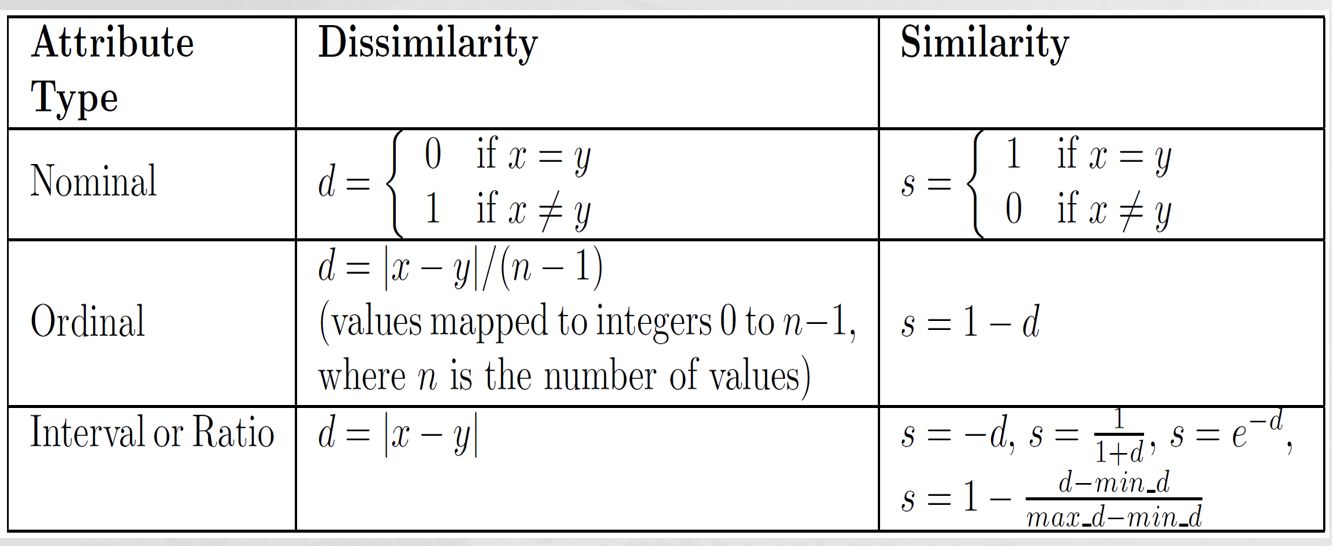
- Dissimilarities between Data Objects
- Euclidean Distance
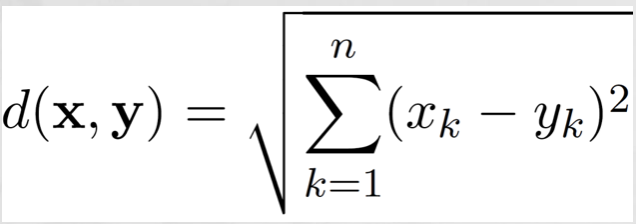
-
where n is the number of dimensions (attributes) and xk and yk are, respectively, the kth attributes (components) or data objects x and y
-
Minkowski Distance

- r = 1. City block (Manhattan, taxicab, L1 norm) distance.
- A common example of this for binary vectors is the Hamming distance, which is just the number of bits that are different between two binary vectors
-
r = 2. Euclidean distance
- r → ∞. “supremum” (Lmax norm, L∞ norm) distance.
- This is the maximum difference between any component of the vectors
- Do not confuse r with n, i.e., all these distances are defined for all numbers of dimensions.
-
Similarity
-
Similarities, also have some well known properties.
- s(x, y) = 1 (or maximum similarity) only if x = y. (does not always hold, e.g., cosine)
- s(x, y) = s(y, x) for all x and y. (Symmetry)
- where s(x, y) is the similarity between points (data objects), x and y.
-
-
Similarity Between Binary Vectors
-
Common situation is that objects, x and y, have only binary attributes
-
Compute similarities using the following quantities f01 = the number of attributes where x was 0 and y was 1 f10 = the number of attributes where x was 1 and y was 0 f00 = the number of attributes where x was 0 and y was 0 f11 = the number of attributes where x was 1 and y was 1
-
Simple Matching and Jaccard Coefficients SMC = number of matches / number of attributes = (f11 + f00) / (f01 + f10 + f11 + f00)
J = number of 11 matches / number of non-zero attributes = (f11) / (f01 + f10 + f11)
-
-
Cosine Similarity
- If d1 and d2 are two document vectors, then cos( d1, d2 ) = <d1,d2> / ||d1|| ||d2|| ,
-
where <d1,d2> indicates inner product or vector dot product of vectors, d1 and d2, and d is the length of vector d. - Example: d1 = 3 2 0 5 0 0 0 2 0 0 d2 = 1 0 0 0 0 0 0 1 0 2
<d1, d2> = 31 + 20 + 00 + 50 + 00 + 00 + 00 + 21 + 00 + 02 = 5
| d1 | = (33+22+00+55+00+00+00+22+00+00)0.5 = (42) 0.5 = 6.481 |
| d2 | = (11+00+00+00+00+00+00+11+00+22) 0.5 = (6) 0.5 = 2.449 |
cos(d1, d2 ) = 0.3150
-
Correlation
- Correlation measures the linear relationship between objects
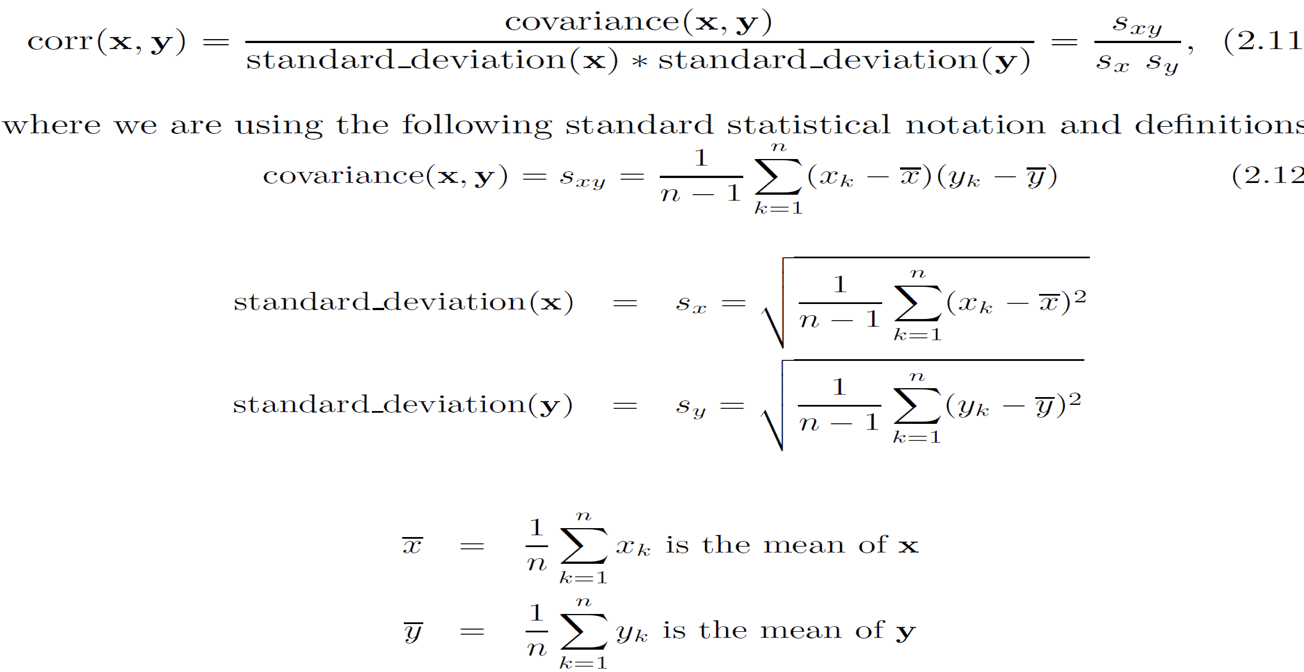
- Visually Evaluating Correlation
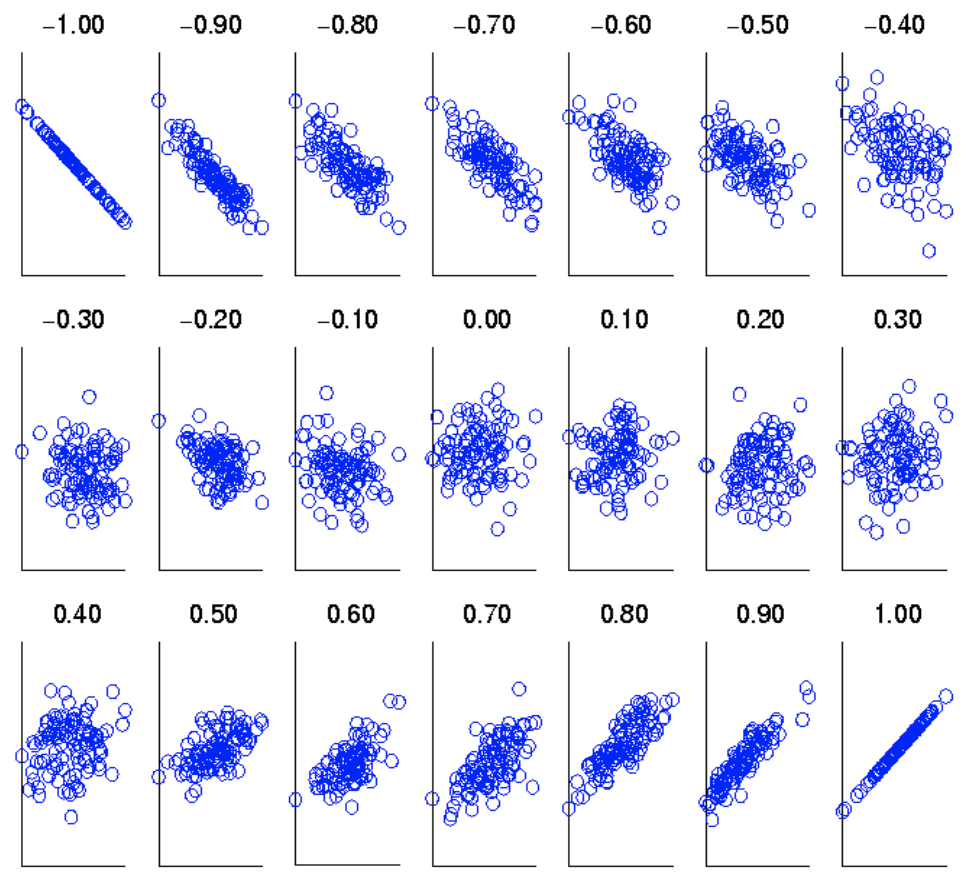
-
Comparison of Proximity Measures
- Domain of application
- Similarity measures tend to be specific to the type of attribute and data
- Record data, images, graphs, sequences, 3D-protein structure, etc. tend to have different measures
- Similarity measures tend to be specific to the type of attribute and data
- However, one can talk about various properties that you would like a proximity measure to have
- Symmetry is a common one
- Tolerance to noise and outliers is another
- Ability to find more types of patterns?
- Many others possible
- The measure must be applicable to the data and produce results that agree with domain knowledge
- Domain of application
-
Combining Similarities
- General Approach for Combining Similarities
- Sometimes attributes are of many different types, but an overall similarity is needed.
- 1: For the kth attribute, compute a similarity, sk(x, y), in the range [0, 1].
- 2: Define an indicator variable, δk, for the kth attribute as follows:
- δk = 0 if the kth attribute is an asymmetric attribute and both objects have a value of 0, or if one of the objects has a missing value for the kth attribute
- δk = 1 otherwise
- General Approach for Combining Similarities

- Using Weights to Combine Similarities
- May not want to treat all attributes the same.
- Density
- Measures the degree to which data objects are close to each other in a specified area
- The notion of density is closely related to that of proximity
- Concept of density is typically used for clustering and anomaly detection
- Examples:
- Euclidean density
- Euclidean density = number of points per unit volume
- Probability density
- Estimate what the distribution of the data looks like
- Graph-based density
- Connectivity
- Euclidean density
- Euclidean Density: Grid-based Approach Simplest approach is to divide region into a number of rectangular cells of equal volume and define density as # of points the cell contains

- Euclidean Density: Center-Based Euclidean density is the number of points within a specified radius of the point
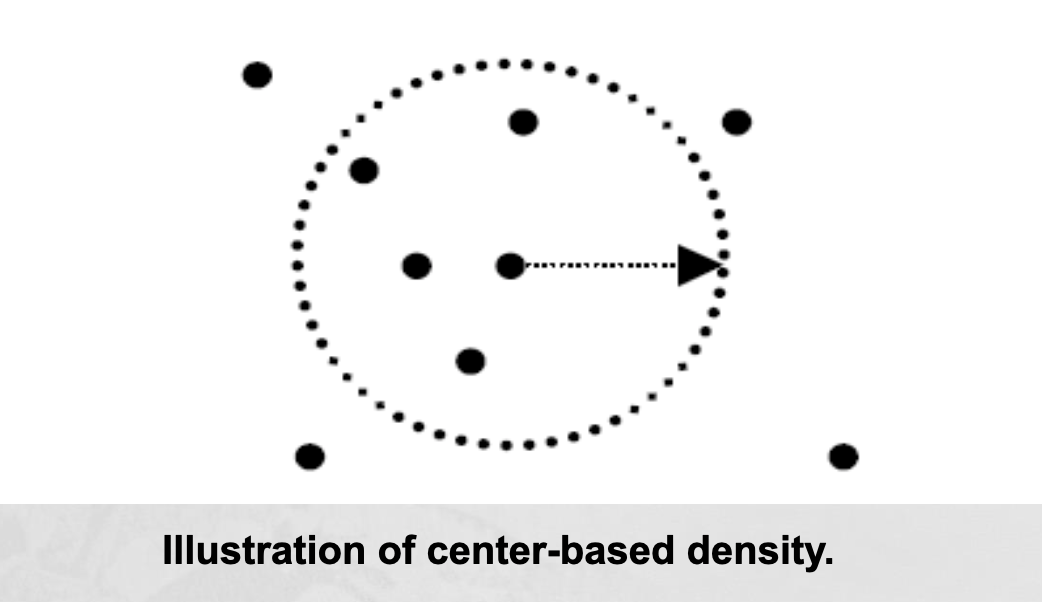




Leave a comment